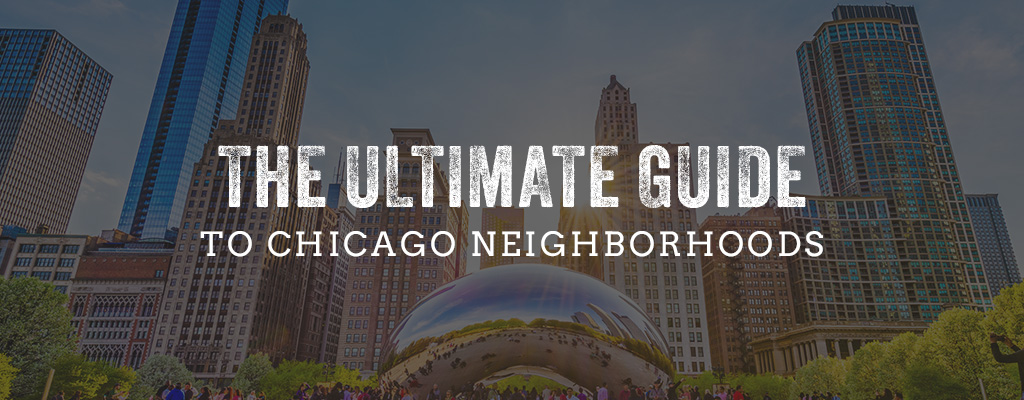
It’s easy to mix up Chicago’s neighborhoods. After all, there are 77 city districts in total — not counting all the distinct communities within those districts. Chicago newcomers sometimes don’t know where to start. If you’re a neighborhood noob, don’t worry, we’ll explain the basics.
Our complete guide to Chicago neighborhoods will teach you the art of navigating these neighborhoods. Buckle in for our ultimate tour. We’re going to visit a number of core Chicago neighborhoods. For each neighborhood, we’ll cover:
- The area’s history.
- Where it is.
- What it’s famous for.
- The area’s demographics.
- The average price of housing.
- The best restaurants.
At Giordano’s, we empathize with novices of the Chicago landscape. We once counted ourselves among the ranks of the uninitiated. When Brothers Efren and Joseph Boglio opened the first Giordano’s in the South Side neighborhood, they had to master the neighborhoods the hard way. Consider yourself lucky. We’ll save you the trouble of learning the old-fashioned way.
As proud Chicagoans, each neighborhood means a lot to us at Giordano’s. We fondly remember those early deep-dish days in the South Side. Today, we cover a lot of ground in Chicago, but we never forget where we came from.
Reconnect with your roots and learn about your neighborhood, or if you’re new to Chicago, welcome! We hope this guide helps you discover where you might want to live.
Andersonville
History
Tucked away in Chicago’s North End, Andersonville boasts a distinctly Swedish cultural legacy. The traditions that early Swedish immigrants brought to Andersonville, continue to this day.
Sweden’s unique cuisine helps define Andersonville’s charm. Walk down North Clark Street and sample some glögg (mulled wine) from Simon’s Tavern or chomp into a weinerbrod custard pastry at the aptly named Swedish Bakery. Don’t forget to buy a tin of sill — who doesn’t love pickled herring on a knäcklebrot cracker with sour cream?
Andersonville’s funky traditions hail from a fascinating history of opportunism and immigration. In the 1880s, a crowded Chicago turned its attention to the undeveloped areas north of the city. Entrepreneurs saw great potential in the forests of the Lake View Township.
Developers fell the trees and used the wood to build houses. The Great Chicago Fire of 1871 prohibited the construction of wooden dwellings in the city, but the North End was unincorporated land, so the city turned a blind eye. Rapid construction, fueled by cheap lumber, boosted the township’s population from 2,000 to 45,000 by 1887.
Lake View Township received its current name, Edgewater, in 1885. The neighboring community of Andersonville experienced a similar boom as Edgewater, thanks to some Nordic newcomers.
As Swedes poured into Andersonville, they put their trademark carpentry skills to use. As construction exploded under Swedish hammers, Andersonville began to take shape. Many of these early buildings survive today, earning the neighborhood its title as a historic district.
Location
This quaint corner of Chicago’s North End lies just south of Edgewater and Magnolia Glens and west of Edgewater Beach, not far from the lake.
Andersonville Is Best Known For
- Swedish Bakeries: Andersonville offers an abundance of delicious Swedish bakeries. Make sure to stop in for fika, the Swedish version of a coffee break.
- Midsummer Festival: Make the Andersonville Midsummer Festival a priority this year. This high-energy public party lets you celebrate the Summer Solstice in Swedish style. Dance around the majstång maypole, drink some elderflower saft juice and snaps and if you’re a young maiden, pluck seven different types of flowers to place under your pillow to dream of your future soulmate.

Demographics
Anderson’s population generally includes higher-income, thirty-something, family-oriented, American-born citizens from outside Illinois, with some hailing from abroad.
Housing Prices
Higher than the Chicago average, the average house costs around $490,000.
Andersonville’s Best Restaurants
- M. Henry: This creative, health-conscious, art gallery cafe, serves delicious dishes inspired by world cuisine and new American-style cooking. M. Henry endeavors to use only the freshest, locally sourced, organically grown ingredients. Their diverse and original menu offers a modern twist on classic American favorites, with a hint of the exotic. It’s a restaurant as idiosyncratic as Andersonville itself.
- Big Jones: The heartwarming food of the American South comes alive at Big Jones. There’s nothing better than familiar Southern classics done well. If you enjoy a drink, join their Big Jones Bourbon Society. Run the gauntlet of their dozens of bourbons and whiskeys to earn the status of Master Taster and win tickets to their special all-out whiskey dinner. Bottoms up.
- Hopleaf: A beer lover’s paradise. As the name suggests, Hopleaf takes beer seriously. The song “99 Bottles of Beer reflects the experience of counting their selection of beers. Hopleaf matches delicious beer with dishes like mussels and frites, chicken and waffles, and sausages (to name a few). Their whole menu celebrates the harmonious marriage of beer and hearty cuisine. Let the symphony of flavors play out on your palette before resting easy in your stomach.
Bucktown/Wicker Park
History
The story of Wicker Park began when brothers Charles and Joel Wicker purchased the area and began development. The brothers bore witness to the Great Chicago Fire of 1871 and championed the use of brick-and-stone buildings in their new neighborhood.
Many of these structures survive today, giving Wicker Park its trademark architecture. The Wicker brothers crafted their project around the centerpiece of a public park. Their self-named Wicker Park represents the true legacy of these generous entrepreneurs.
Just north of Wicker Park lies Bucktown. This neighborhood proudly maintains a history of cultural diversity, even including members of different species. Bucktown got its moniker from its resident goats, or bucks.
Bucktown began as the township of Holstein. Located on the outskirts of Chicago, waves of Polish immigrants settled in this community starting in the 1830s. A number of Polish churches recall the influence of these early Bucktown pioneers.
After Chicago incorporated Holstein in 1863, the neighborhood underwent another growth spurt. As this new neighborhood housed a sizable number of goats, usually kept by Poles, Holstein rebranded itself as Bucktown.
As the goat craze faded, new immigrant communities established themselves in Bucktown. Besides Poles, many German, Latino, Scandinavian, Jewish and African American people also call this neighborhood home.
You’re unlikely to meet a goat in Bucktown nowadays, but the mosaic of interwoven cultures more than compensates for the disappearance of Bucktown’s cloven-hoofed namesake.
Location
Bucktown and Wicker Park are surrounded by Logan Square and Humboldt Park to the west, West Town to the south, the North Branch Chicago River to the east and the Kennedy Expressway wrapping around as a border to the north.
Bucktown/Wicker Park Is Best Known For
- Hipsters: Wax up your mustache, button your grandfather’s suit and ride your unicycle down to the hipster hotspots of Wicker Park and Bucktown. No, you’re not a circus performer — you’re a confident hipster. Wear your flannel shirt wide open. Everyone should see the pop-culture T-shirt of your choice beneath your suspenders. Proudly flaunt your ironic attitude — this is your town. It’s fun to mock hipsters, especially since they love to join right in — self-reference is key. Never rudely call one out (to their face). Who knows, you might even be a hipster yourself. These two neighborhoods host lots of cool hipster haunts. Walk around and see what you find.
- Great nightlife: Wicker Park and Bucktown stake their name in the nightlife. Tons of bars and nightclubs pack the streets, appealing to your weekend temptations. During the day, visit the cornucopia of cafés and boutiques along North Avenue and Damen, and unwind at a Chicago dive bar at night. Keep it casual.
Demographics
Wicker Park and Bucktown share a similar demographic trend. Most residents are between age 25 and 34. This younger crowd rakes in more income than the city average but also pays more rent. Half of both populations hail from Illinois, and around 10% are foreign-born residents.
Housing Prices
Detached houses go for around $560,000 in Bucktown and around $630,000 in Wicker Park — both above the Chicago average.
Bucktown/Wicker Park’s Best Restaurants
- Big Star: No, it’s not named for the legendary pop band from the ’90s, but Big Star does make some rockin’ food. This top-notch taco bar mixes ingredients from around the globe to muster some macho tacos. Come and crunch into Mexican flavor heaven.
- Xoco: This acclaimed Mexican-inspired restaurant elevates classic recipes to the next level. Xoco, pronounced “Sho-ko,” takes its name from the Aztec word for “little sister,” and like the respect paid to the preciousness of family, Xoco honors its Mexican roots by letting recipes grow and develop, with the guiding hand of an older sibling. Sample their trademark churros, delicate and crisp empanadas, torta, caldo bowls and soothingly delicious Mexican hot chocolate.
- Le Bouchon: French cuisine maintains its prestige because of restaurants like Le Bouchon. This quintessentially French restaurant carries the torch of the French tradition. Le Bouchon stocks all the classics, including steak frites, bouillabaisse, steak tartare and even cuisses de grenouille, or frog legs. Journey down for the true taste of France.
- Piece Pizza: We at Giordano’s live for great pizza. We appreciate the art of pizza mastery and Piece Pizza has got what it takes. With an assortment of beers, they offer whatever you’re feeling. Head down for a pizza and beer. They get the Giordano’s seal of approval, and we know pizza.
- Doves Luncheonette: With a nod to classic Chicago soul and blues, chef de cuisine Dennis Bernard paints a scene of the American South on the plate. Incorporating elements of Mexican food, Doves Luncheonette fuses styles, traditions, and eras. The restaurant seeks to recall the bygone days of community lunch counters with good food, good music, and good friends.
- Mindy’s Bakery: Few restaurants do desserts like Mindy’s. With a constantly evolving menu of elegant and diverse sweets, Mindy’s makes an excellent evening stop. You’ve never had a hot cocoa like Mindy’s.
- Cumin: Named for that all-purpose spice known throughout the world, Cumin incorporates all realms of earthly knowledge into its cooking. Centering on modern Nepalese and Indian cuisine, Cumin will have you coming back again.
- Mott Street: This modern Korean-fusion restaurant showcases the versatility of Korean cuisine. Their team of world-class chefs move like acrobats in the jungle gym of fusion cuisine. Their creations are nothing short of superlative. Try their Kimchi and Oaxaca empanadas or candied shrimp and kohlrabi salad to see what we mean.
- Bongo Room: For more than 20 years, Bongo Room has treated breakfast right. Bongo Room’s long-term success makes sense once you try their pancakes or anything else they offer. It’s definitely one of the best breakfast joints in town — start the day off right at the Bongo Room.
Gold Coast
History
This certified historic district emerged after the Great Chicago Fire. In the 1880s, real estate tycoons shifted their attention north to the undeveloped lakeside. In 1882, bigwig developer Potter Palmer relocated to the area.
Filling in the swamp, he constructed his personal Xanadu, Palmer Mansion. His shift north galvanized the salons of the Chicago elite, and many followed in his footsteps north. This established the Gold Coast’s legacy of wealth, which continues today.

Location
Along the lakeside, within walking distance of Oak Street Beach, Old Town sits to the west, and the Magnificent Mile leads to the Gold Coast from the south.
Gold Coast Is Best Known For
- Shopping. Naturally, this high-end neighborhood hosts some high-end shopping. Grab your Versace or Dolce & Gabbana — let your status symbols work their magic.
Demographics
This densely packed neighborhood houses wealthy 30- to 35-year-olds.
Housing Prices
The average cost of a home here is about $345,000.
Gold Coast’s Best Restaurants
- Giordano’s Pizza: Visit our Gold Coast/Magnificent Mile location at 730 N. Rush St. and treat yourself to a deep-dish slice in this decadent neighborhood. Call us at 312-951-0747.
- Le Colonial: This French Vietnamese restaurant embarks on a culinary voyage to a forgotten era. The crossover of styles meshes perfectly at Le Colonial.
- The Halal Guys: Delicious Middle Eastern fast food like chicken gyro wraps and falafel offers a great meal on the go. Made to order, spiced to perfection and complete with all the sides, you’ll holler for the Halal Guys.
Lakeview
History
Lakeview took shape later than other neighborhoods. Finally, in the 1850s, this far-flung northern area received a number of German and Swedish settlers. This sparse land hosted a Civil War encampment after 1864. Camp Fry trained members of the Illinois infantry. After the troops departed to Kentucky, Camp Fry converted to an internment camp for Confederate POWs.
After the war, Lakeview’s population of Lakeview steadily increased. A major boom in the late 1880s accompanied the rise in infrastructure and public services.
Location
As the name Lakeview suggests, this neighborhood lies along Lake Michigan. Lincoln Park sits to the south, Roscoe Village to the west and Uptown to the north.
Lakeview Is Best Known For
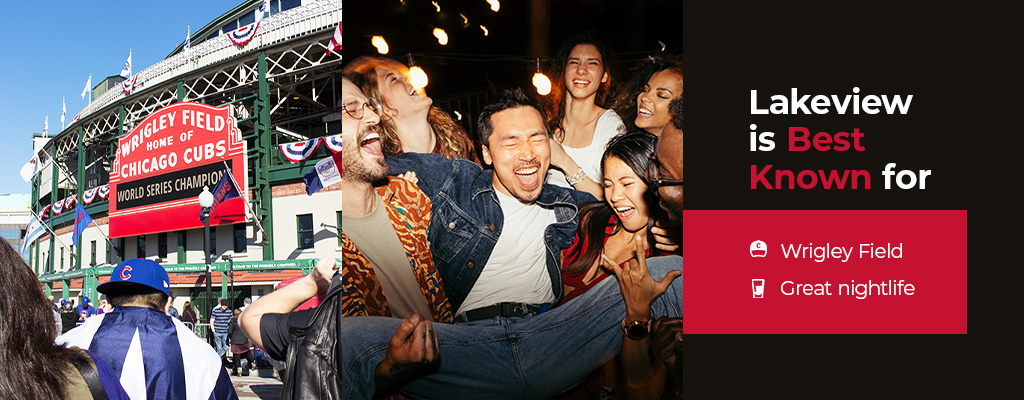
- Wrigley Field: Lakeview famously hosts the home of the Chicago Cubs at Wrigley Field. We at Giordano’s love attending Cubs games so much that we moved into Wrigley Field. Nothing tops a deep-dish pizza at a Cubs game — we also sell individual thin crust or deep-dish slices.
- Great nightlife: Lakeview boasts everything from trendy nightclubs to laid-back bars. Everything a weekend warrior could want.
Demographics
Lakeview maintains a large population of young and vibrant inhabitants. Most people are in their late twenties.
Housing Prices
Detached houses go for about $390,000, but most units comprise large apartment buildings.
Lakeview’s Best Restaurants
- Giordano’s Pizza:Enjoy the pizza you know and love in the heart of Lakeview. Step into our location at 1040 W. Belmont Ave or give us a ring at 773-327-1200. See you there.
- Crisp: Sample the tangy Korean fried chicken or a hearty Buddha Bowl at Crisp. The name says it all — it’s crunchy, fresh and satisfying.
- 3rd Coast Fish Bar: Wade into Fish Bar for some Southern seafood specialties like po’boys, catfish, hush puppies and whole oysters.
- DMK Burger Bar: We let DMK Burger Bar speak for themselves — “Best damn grass-fed burgers, shakes and fries that ever hit your lips.” See for yourself.
Lincoln Park
History
On the north side of Chicago, fairly close to the lake, you’ll find Lincoln Park. Before the Civil War, this enormous 60-acre space of land was known as Lake Park. After the assassination of Abraham Lincoln, city officials had it renamed the area Lincoln Park.
After the name change, Lincoln Park obtained funding for the now iconic zoo. Founded back in 1868, Lincoln Park Zoo is one of the longest-standing zoos in the nation. This free attraction holds a veritable ark of animals, including penguins, giraffes, gorillas, reptiles, large polar bears and various species of monkeys and an Amur tiger.
Location
This lakeside neighborhood lies south of Lake View, east of Bucktown and north of Near North Side.
Lincoln Park Is Best Known For
- Lincoln Park Zoo: The Lincoln Park Zoo is a fun way to enjoy the day. The zoo exemplifies Lincoln Park’s history as a central attraction of Chicago.
- Fullerton Beach: Jump on into the lake or walk along the vast beachfront of Fullerton Beach. Nothing beats a day at the beach. Because Lake Michigan is freshwater, you won’t feel like a french fry after you dry off.
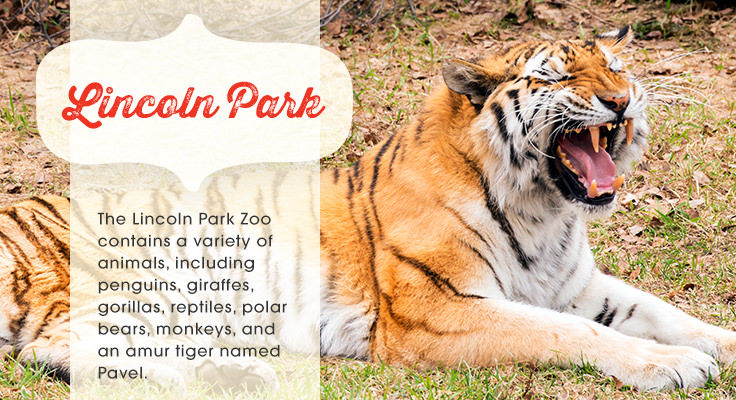
Demographics
Middle-income thirty-somethings represent the norm in Lincoln Park.
Housing Prices
The average cost of a home here is around $550,000.
Lincoln Park’s Best Restaurants
- Athenian Room: Enjoy delicious Greek comfort food at an affordable price. Their roasted chicken even garnered the praise of Second City celeb Tina Fey. She once praised this eatery for creating her “favorite meal.” We can’t beat that recommendation.
- Café Ba BaReeba: Northern Spanish-style pintxos tapas are a specialty of Café Ba BaReeba. Only a few dollars for a tapa?! What are you waiting for? ¡Arriba!
- Del Seoul: This Mexican-Korean fusion eateryboasts the best of both cuisines. Take a trip with this stylistic hybrid of Asian and Latin flavors.
- Mon Ami Gabi: Mon Ami Gabi does classy cooking in an effective way. If you’re an aficionado of French cuisine, definitely visit this premiere Lincoln Park bistro.
- MFK: Is that the ocean calling, or just your hunger? Either way, paddle down to this acclaimed seafood restaurant. They won the Chicago Tribune Diners Award in 2015. Test the waters — you’ll like what you find at MFK.
- Summer House Santa Monica: This relaxing restaurant will brighten your day with its airy atmosphere and vibrant cuisine. The crisp freshness of the food matches this beach-inspired restaurant perfectly. Forget the towel and just bring your appetite.
- Riccardo Trattoria: We at Giordano’s respect high-quality Italian food. Riccardo Trattoria upholds the same primo standard of Italian food, which we strive to honor ourselves. Don’t miss out on this truly exceptional restaurant.
Logan Square
History
Logan Square derives its name from the mustached Civil War General John A. Logan.
Location
Logan Square lies west of Bucktown, east of Hermosa, North of Humboldt Park and south of Avondale.
Logan Square Is Best Known For
- Logan’s statue: As a native of Illinois, Chicago honored Logan with his memorial eponymous square and an impressive statue in Grant Park. If you’re feeling the Logan vibe, take a walk down Logan Boulevard while singing the Illinois state song — which also mentions Logan. If Logan had found a time machine and arrived in modern Logan Square, the general’s outlandish mustache wouldn’t have raised any eyebrows in this fledgling hipster neighborhood. The neighborhood that honors his name also honors his style.
- Logan Theatre: This iconic vintage movie theatre is a central attraction that came to life back in 1915. It has since been revamped and now includes a relaxing bar and lounge area. The theatre screens everything from classics to modern marvels.
Demographics
Most of the people in Logan Square are in their late 20s and early 30s. Compared to the other neighborhoods we’ve covered, Logan Square is defined by a more modest income.
Housing Prices
Homes in Logan Square are valued at an average rate of about $470,000.
Logan Square’s Best Restaurants
- Giordano’s Pizza: A deep-dish pizza offers a perfect finishing touch to a day in Logan Square. Check out our spot at 2855 N. Milwaukee Ave or call 773-862-4200.
- Bang Bang Pie & Biscuits: Dessert done right. Their eclectic menu of pastry delights will fix your nagging sweet tooth. Give in to temptation.
- Longman & Eagle: Start the day off at Longman & Eagle. Logan Square’s breakfast champs will charge your batteries with their legendary breakfasts.
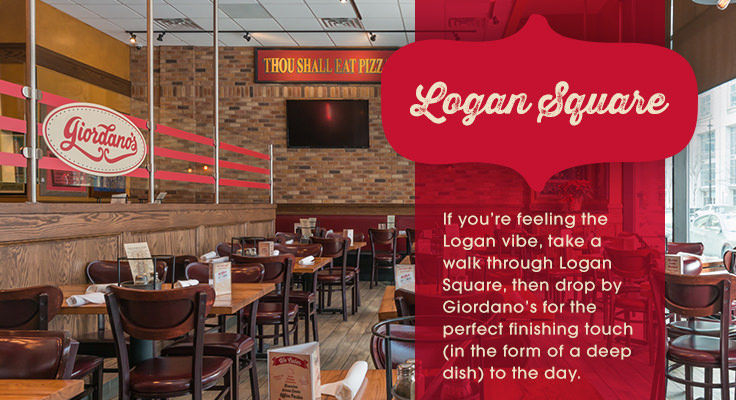
The Loop
History
This prestigious neighborhood provided the birthplace of Chicago. In 1803, the army erected Fort Dearborn near present-day Michigan Bridge. Increased settlement of the area paved the way for rapid development.
The neighborhood assumed the nickname “the Loop” after the El Train created a natural loop around the area following its completion in 1897.
Walk around this neighborhood and absorb the visual splendor of Chicago’s architectural heritage. Austere Art Deco buildings cast a spellbinding power over the area. Conjuring dark dreams of the past — no wonder downtown Chicago stars in the role of Gotham in the latest Batman movies.
Location
The Loop is the central business district of Chicago, home to City Hall and the Seat of Cook County. On the north and west is the Chicago River, on the east is Lake Michigan and on the south is Roosevelt Road.
The Loop Is Best Known For
- Skyscrapers: Buzzing with commercial hubbub, the Loop acts as Chicago’s financial heart. Skyscrapers reach dizzying heights as the streets below flow in a sea of suits. Elegant boutiques line the sidewalks of State Street. The Loop celebrates the ostentatious side of the city.
- Famous landmarks: Many Chicago landmarks pack this larger-than-life neighborhood. The Willis Tower (or Sears Tower to true Chicagoans), City Hall and numerous theatres and opera houses all call the Loop home — and so does Giordano’s!
- Giordano’s “Pie in the Sky”: At Giordano’s, we take the expression “pie in the sky” literally. It’s no fantasy — this restaurant is real. Perched above the city on the 103rd floor of the Sears Tower sits our highest pizza location. We call it our “Pie in the Sky.” The incredible view from up there only complements our deep-dish pizza. Honestly, what’s more “Chicago” than eating a deep-dish slice at the Sears Tower? Give in to this perfect combo of Chicago heavyweights. See you up there.
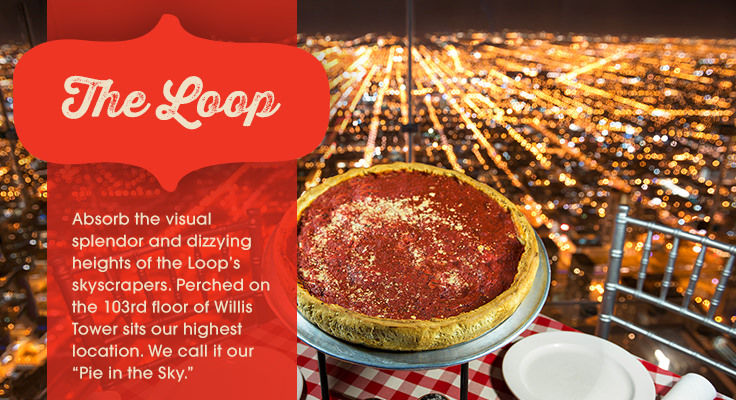
Demographics
The median age in the Loop is 36.
Housing Prices
This area is not particularly residential, but some options exist. The average selling price for residences here is about $270,000.
The Loop’s Best Restaurants
- Giordano’s Pizza:Afraid of heights but still want deep-dish pizza? Snag a pie at ground level at our Loop location at 223 W. Jackson Blvd. Call if you like at 312-583-9400.
- Luke’s Lobster:Put your exoskeleton-cracking talents to use at Luke’s Lobster. Bib up and get down.
- Blackwood BBQ:Smokey, flavorful and mouthwatering BBQ, Chicago-style.
- The Gage: Regular rules don’t apply at The Gage. Scotch egg, tuna tartare, poutine, you name it. The Gage creates its own gauge to measure its performance. Prepare for optimum cuisine.
- M Burger:Delectable burgers at a reasonable price make a top-notch meal. Your wallet and stomach will thank you.
- Cafecito: There’s nothing diminutive about the taste of Cafecito’s grill-pressed Cuban sandwiches and robust Cuban coffee. It’s an ideal afternoon lunch spot.
Lincoln Square
History
This neighborhood owes its development to waves of German immigrants. Establishing themselves on the outskirts of Chicago, Lincoln Square grew with community. It received the name Lincoln Square in 1925.
Location
This North End neighborhood lies southeast of Andersonville.
Lincoln Square Is Best Known For
- Old Town School of Folk Music: Offering a charming vibe, the decades-old school moved to the neighborhood in 1998 and helped make the area a hotspot for dining and nightlife before and after concerts.
- Davis Theatre: This century-old movie theatre contains organ pipes and a hand-painted ceiling. This vintage movie space showcases old classics, cult favorites and vintage films.
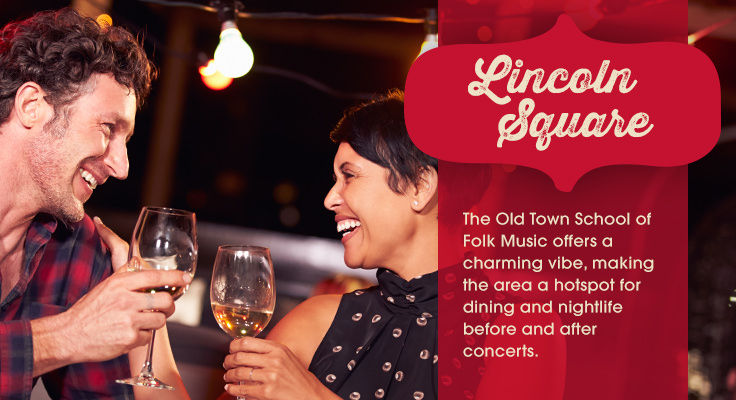
Demographics
Many young families call this highly residential neighborhood home. Most people fall into the 35-40 age bracket.
Housing Prices
The abundance of houses attracts many young families. The average house sells for about $440,000.
Lincoln Square’s Best Restaurants
- Giordano’s: Nothing complements your time in Lincoln Square like our deep-dish pizza. Make time for an unforgettable meal at Giordano’s. Visit our place at 2010 W Montrose Ave or call us directly at 773-275-4600.
- Gather: This reasonably priced restaurant has one foot in Europe and the other in America. Its continent-spanning menu is guaranteed to please.
- Gene’s Sausage Shop & Delicatessen: With over 40 varieties of homemade natural wood-smoked sausages, Gene’s provides a true shrine for sausage worshipers. Come in, what’s the wurst that could happen?
Old Town
History
It should come as no surprise that Old Town wasn’t always old. One hundred years ago, Old Town was called “the Cabbage Patch” — and not because of those dolls from the ’80s. The German immigrants who built Old Town grew cabbage fields — and the name stuck.
Eventually, the name Cabbage Patch fell out of style, and the area became “North Town.” Although some still call the neighborhood North Town, we know it as Old Town.
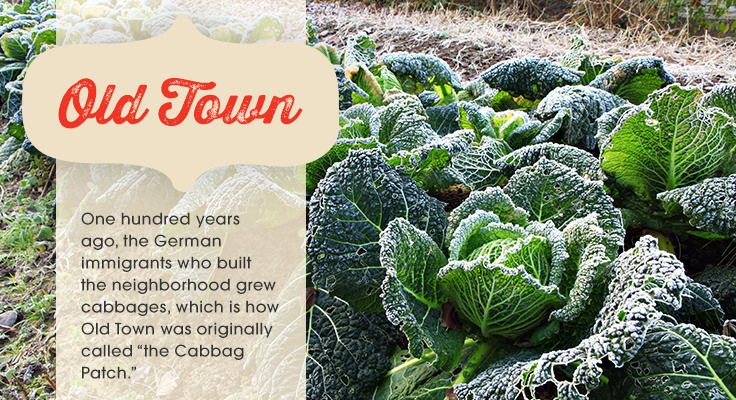
Location
Beside the Gold Coast, it is north of Near North Side.
Old Town Is Best Known For
- The Second City:This Chicago comedy outlet routinely turns out legendary performers. John Belushi, Stephen Colbert and Tina Fey, among others, began at this landmark improv theatre in Old Town. Visit their website and get tickets to see the next batch of groundbreaking comedians.
- The Old Town Art Fair: This iconic art fair lures hundreds of national artists to exhibit their creative minds in a free-spirited outdoor festival.
Demographics
An older crowd lives in Old Town — maybe they’re attracted by the name. The average age for residents is 37 years old.
Housing Prices
Old Town features some beautiful heritage buildings. The homes here sell for around $380,000 on average.
Old Town’s Best Restaurants
- Topo Gigio Ristorante:Enjoy deeply satisfying Tuscan-inspired cuisine in a laid-back and friendly restaurant. Their gorgeous garden and covered outdoor dining room make for perfect alfresco dining year-round.
- Kamehachi:Savor classic Japanese food done immaculately. Noodles, Nigiri, Moriwase Sashimi and Sushi — Kamehachi has your favorites.
- Kanela Breakfast Club:Order a decadent Greek-inspired breakfast at this eatery. You’ll find gourmet Mediterranean-style meals at a pocket-friendly price.
South Loop
History
Always close to the action, South Loop rode the wave of development propelled by its commercial neighbor, the Loop. While its neighbor basked in metropolitan glory, South Loop humbly accepted the less glamorous warehouses and factories.
South Loop relaxed into its role as “the wrong side of the tracks.” It gained a reputation as a vice-ridden haven for brothels, bars and arcades. In the 1970s, Chicago gentrified the area, and now all those old warehouses are studio apartments.

Location
It’s next to the lake, flanked by Chinatown to the west, South Commons to the south and the Loop to the north.
South Loop Is Best Known For
- Being many different things to many different people: Offering a mix of attractions and histories, South Loop is an assortment of cultural treasures, such as Shedd Aquarium, Grant Park, Alder Planetarium and Field Museum.
- Lakefront Museum Campus: This space brings together all the biggest museums in the region.
- Shoreline Sightseeing Water Taxi: This tourist attraction takes you from the shoreline to the Shedd Aquarium, where you can see tens of thousands of aquatic life from around the world.
- Adler Planetarium: This planetarium is the first in the United States. The attraction is an iconic place that welcomes countless tourists every year.
Demographics
Tens of thousands of people pack into this dense neighborhood. Most people fall between the ages of 30 and 40 and rake in a much higher income than the city average.
Housing Prices
Residential housing trends toward townhouses and five-or-more unit structures. Homes cost an average of about $300,000.
South Loop’s Best Restaurants
- Giordano’s:Your favorite deep-dish place has a location in South Loop at 1340 S. Michigan Ave. Come in after a day looping around the neighborhood. Call us at 312-842-1100.
- Devil Dogs South Loop:Nothing beats a downtown hot dog skillfully dressed in your favorite fixings. It’s open late for those uncontrollable nighttime dog urges. Indulge in the dog.
- Little Branch Cafe: Visit this hip, laid-back cafe that serves an awesome cup of Joe.
- Meli: Named after the Greek word for honey, Meli will sweeten your day with its Greek-inspired breakfasts.
River North
History
Nowadays, upscale shops and art galleries line the streets of River North, but this neighborhood wasn’t always so picture-perfect. In the late 1800s, River North went by the name Smokey Hollow. Pollution from coal deposits, factories, railway yards and shipping ports filled the air with dark fumes, sometimes even obfuscating the sun.
After the 1950s rolled around and the city’s populous emptied into the suburbs, a long decline set upon Smokey Hollow. However, in 1974, a real estate campaign renamed the neighborhood “River North” and transformed abandoned warehouses into spacious art galleries. This trend continued, and River North Galley District coalesced into its present incarnation.
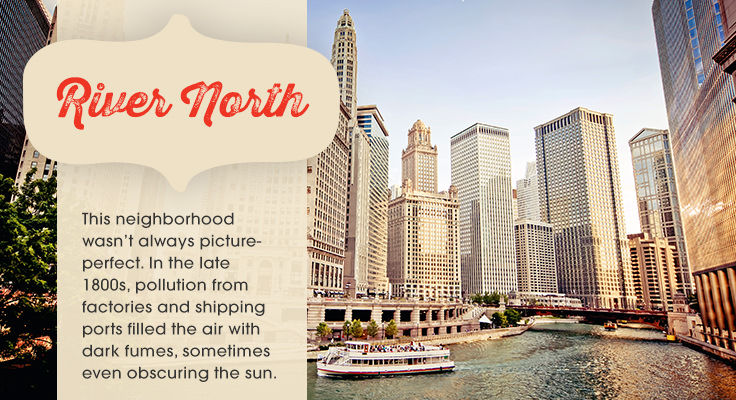
Location
River North appropriately sits north of the Chicago River, above the Loop, below Near North Side and to the west of Streeterville.
River North Is Best Known For
- Richard H. Driehaus Museum: Otherwise known as Chicago’s “Marble Palace,” this iconic museum showcases the Gilded Age.
- THE MART: This is a famous landmark located on the Chicago Riverwalk. You can view high-end interior design studios and be inspired by the globe’s biggest video production art installations.
Demographics
High-income people in their mid-thirties form the main demographic.
Housing Prices
Nearly all residences are townhouses for around $320,000 on average.
River North’s Best Restaurants
- Portillo’s: This all-American joint dishes up some mind-blowing burgers. Relieve your beef craving at Portillo’s.
- Joe’s Stone Crab:Break out the mallet and get cracking at this premium seafood establishment. With great steaks, too, Joe’s Stone Crab serves up a sublime surf and turf.
West Loop
History
West Loop began as an industrial zone, home to factories and warehouses. Since those grimy years of exhaust fumes and workhouses, West Loop has metamorphosed into a sleek and modern neighborhood.
Even Oprah Winfrey nurtures a soft spot for West Loop — her groundbreaking talk show operated from Harpo Studios in West Loop for many years.
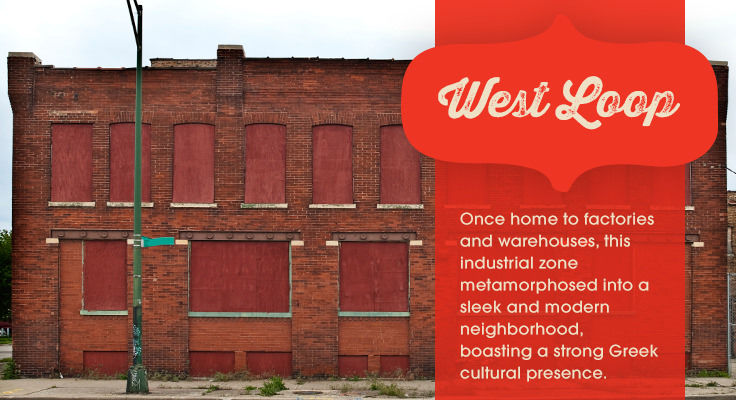
Location
Situated in the Near West Side district, West Loop naturally sits west of the Loop, north of University Village and Little Italy.
West Loop Is Best Known For
- Greektown:The center of Greek culture in Chicago, Greektown boasts an array of Greek restaurants and shops. Catch the annual Greek Independence Day Parade and year-round events, like Greek Christmas.
- National Hellenic Museum: This is one of the oldest museums in the U.S. It is dedicated to honoring Greek culture.
- Epiphany Center for the Arts: Previously an old church, this building was revamped to showcase art exhibitions that range from live music and performing arts to visual displays.
Demographics
A higher-income, mid-thirties crowd populates West Loop.
Housing Prices
Most people live in apartments, but homes generally cost around $290,000 on average.
West Loop’s Best Restaurants
- Giordano’s: At our Greektown location, in the heart of the Greektown restaurant scene, we count ourselves among the fine company. Visit us at 815 W. Van Buren St. Our number is 312- 421-1221.
- The Publican: This fine-dining restaurant specializes in aged ham and fish, but their lively salads rival the product of any animal.
- J.P Graziano’s: This Italian grocery and sub shop maintains a long history with Chicago. Since it opened in 1937, it’s given us some legendarily good subs. Come and experience the subs yourself.
- Girl & the Goat: This memorably named restaurant offers an equally unforgettable dining experience. Their influences cast a wide net, freely experimenting with Indian, Asian, European and Mediterranean flavors.
- Green Street Smoked Meats: This “nationally acclaimed” BBQ place is pure Texas — exceptional BBQ in an easy-going atmosphere.
Get Out and Discover New Neighborhoods

Congrats! You made it. As you’ve seen, Chicago offers a wide variety of options. Listen to your intuition and you’ll find the right neighborhood for you. We hope this guide assists you in your journey to Chicago acclimation. If you’re visiting or already living in Chicago, visit one of Giordano’s many locations. Call for delivery or pickup and try our frozen pizzas.
Share this guide on social media, especially if you know someone coming to Chicago. They’ll thank you and might even buy you a deep-dish slice. We know you’ll love it.